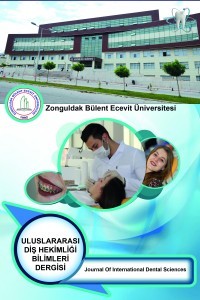Rotasyona Uğramış Üst Santral Kesici Dişi ve Gömülü Dişi Olan Hastanın Tedavisi: Olgu Sunumu
Treatment of a Patient With Rotated Upper Central Incisor and Unerupted Tooth: Case Report
Aesthetics, Smile, Orthodontics, Rotation.,
___
- 1. Proffit W, Fields HW, Sarver DM. Orthodontic Diagnosis. In: Proffit W, Fields HW, Sarver DM, authors. Contemporary orthodontics 4th ed. Elsevier Health Sciences; 2006. 189.
- 2. Leo M, Cerroni L, Pasquantonio G, Condò SG, Condò R. (2016). Temporary anchorage devices (TADs) in orthodontics: review of the factors that influence the clinical success rate of the mini-implants. La Clin terap 2016, 167: e70.
- 3. Arnett GW Bergman RT. Facial keys to orthodontic diagnosis and treatment planning part-II. Am J Orthod Dentofacial Orthop 1993; 103: 395-411.
- 4. Cash AC, Good SA, Curtis RV, McDonald, F. An evaluation of slot size in orthodontic brackets-are standards as expected?. Angle orthod 2004;74: 450-453.
- 5. Song YY, Cha JY, Hwang CJ. Mechanical characteristics of various orthodontic mini-screws in relation to artificial cortical bone thickness. Angle orthod 2007; 77: 979-985.
- 6. Cheng, SJ, Tseng IY, Lee JJ, Kok SH. A prospective study of the risk factors associated with failure of mini-implants used for orthodontic anchorage. Inter J Oral Maxil Imp 2004; 19: 100-106
- 7. Sarver DH. Principles of cosmetic dentistry in orthodontics Part 1.Shape and proportionality of anterior teeth. Am J Orthod Dentofacial Orthop 2004; 126: 749-753.
- 8. Suliman A, Qaisi RH. Smile perception in dentistry. Cairo Dental Journal 2009; 25: 53-60.
- ISSN: 2149-8628
- Yayın Aralığı: Yılda 3 Sayı
- Yayıncı: Zonguldak Bülent Ecevit Üniversitesi
Travmaya Uğramış İmmatür Maksiler Daimi Ön Kesici Dişin Pulpa Revaskülarizasyonu: Bir Olgu Raporu
Tuğba NALE, Levent DEMİRİZ, Ebru HAZAR BODRUMLU
Astım Hastalığı ve Çocuklarda Ağız Diş Sağlığı*
Mustafa TAŞKIN, Ebru HAZAR BODRUMLU
Ecehan HAZAR, Baran Can SAĞLAM, Ahmet HAZAR
Ortodonti ve Gülümseme Estetiği
Çağla BÖREKÇİ, Nurhat ÖZKALAYCI
Sürmemiş Odontomaların Konik Işınlı Bilgisayarlı Tomografi CBCT İle İncelenmesi
Gökhan GÜRLER, Çağrı DELİLBAŞI, Kader AYDIN
Farklı Renkteki Rezin Simanların CAD/CAM Seramiklerin Rengine Etkisi-Pilot Çalışma
Şeyda ADIGÜZEL, Neslin VELİOĞLU, Seda CENGİZ, Selçuk ORUÇ
Gömülü Santral Dişlerin Sürdürülmesinde İki Farklı Teknik ile Tedavi Edilen İki Olgu
Fethiye ÇAKMAK ÖZLÜ, Hakan YILMAZ, Engin YILDIRAN, M İnanç CENGİZ, Akif TURER
Komplike Kron Kök Kırığı Bulunan Dişlerin Reataçman Tekniği Kullanılarak Multidisipliner Tedavisi
Ata Hikmet TIMUR, Taha ÖZYÜREK, Umut MISILLI
Rotasyona Uğramış Üst Santral Kesici Dişi ve Gömülü Dişi Olan Hastanın Tedavisi: Olgu Sunumu
